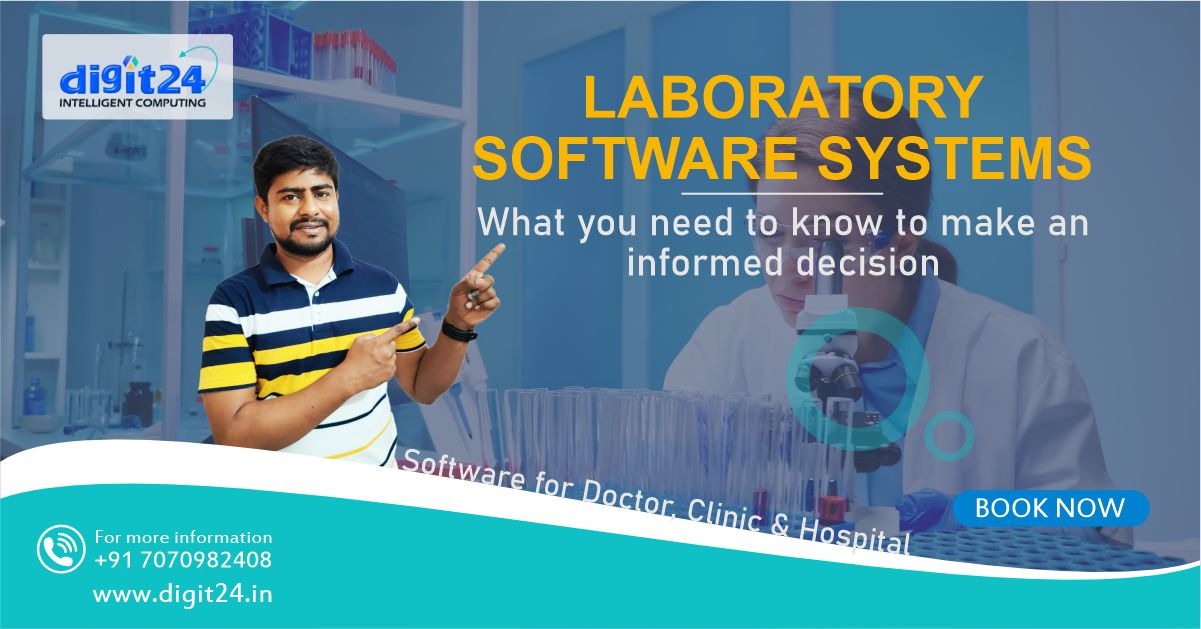Laboratories are big business. The global clinical laboratory services market is estimated to be valued at approximately $200 billion and is projected to reach approximately $290 billion by 2028. Later in this article, we’ll look at the key drivers of this growth and what they can tell us about the future. laboratory software.

To Get Best Pathology Lab Management Software : CLICK HERE
Types of Lab Software Systems
Laboratory software terminology can be confusing. Sometimes the definitions are vague or change over time. For example, laboratory information systems (LIS) and laboratory management information systems (LIMS) used to refer to very different concepts, but today their meanings overlap and some people use them interchangeably. Or, to take another example, the term laboratory management software may be used as a synonym for laboratory information systems, but it is used more broadly to refer to any software used by a laboratory. can go.
Taking this a step further, we call our system an “Operating Platform” because it goes beyond the fundamentals of the LIS or LIMS system and serves as an end-to-end enterprise-grade software solution for all medical laboratories. does.
The LigoLab LIS and RCM operating platforms include modules for AP, CP, MDx, RCM and direct-to-consumer, all on a silo-free integrated platform that supports every role, every department and every case, allowing It helps labs differentiate themselves. In the market, scale your operations, and become more profitable.
In this article, we will use the terms lab software system and laboratory management software to refer to all software used in a laboratory environment, and we will define commonly used software.
Lab Data Management System Reporting
Reporting has become an increasingly important component of laboratory information software. Third-party payers are increasingly demanding that laboratories interface with them through their automated electronic portals, and that the best LIS solutions come preloaded with generic, customizable templates. It’s worth noting that this is another area where definitions are blurry; Reporting and communication with billing services can also be considered as a domain of Revenue Cycle Management (RCM) which is discussed below.
The LigoLab platform is equipped with a powerful reporting engine that makes every element of the reporting template for both LIS and RCM functions fully customizable. For a closer look at examples of report templates created by the platform, we invite you to take advantage of our free downloads to see how these templates can add value to your customers.
Lab Information System (LIS)
Laboratory information systems are the most common software suites that can typically be found in a laboratory. Traditionally, a LIS brings all parts of a laboratory under one software umbrella and establishes and maintains a centralized database for all laboratory departments and processes. As such, it is responsible for the data collection, management and reporting requirements of the laboratory. It also allows it to manage laboratory process workflows.
Since the LIS is usually the central repository of all data relating to patients and their specimens, it is designed in accordance with the guidelines of the CAP (American College of Pathologists), CLIA (Clinical Laboratory Improvement Amendment), HIPAA (Health Insurance Portability and It needs to operate effectively inside. Accountability Act), and other regulatory agencies to reduce compliance concerns and avoid penalties.
Some of the processes managed by LIS software include.
Collection of patient demographic data (age, gender, ethnicity, blood type, etc.)
Tracking of samples and test results for individual patients, including pooled testing capabilities.
Order tracking
Quality control
Diagnosis and treatment recommendations
Interoperability with instrumentation
Interfacing with third parties, including physicians and insurance companies
Data analysis and reporting, including audit capabilities
With automated and electronic workflow queues, modern LIS has made paper-based records and legacy IT systems obsolete, resulting in fewer errors, faster processing times, lower human resource costs and increased scalability.
With LigoLab’s all-in-one platform, users are freed from restrictions such as paper forms and siled systems that prevent maximum interoperability and efficiency. With a combined software infrastructure, end-to-end data integrity is ensured.
Lab Information Systems Vendors
The LIS market in the U.S. is approximately $2 billion and is projected to grow at 6.5 percent per year over the next decade. Most LIS vendors are responding to laboratories’ demand for information technology to support higher productivity, lower costs, fewer errors, and better data management and analysis. These needs are compounded by external pressure on laboratories to provide seamless integration with third parties such as public health agencies, payers, physicians and billing services. Laboratories using legacy systems that lack functionality (modules and features) and preclude scalability are at a definite disadvantage, while laboratories that embrace future-ready and scalable systems are increasingly able to adapt to rapidly changing markets. can be adapted to.
Lab Information Management Software (LIMS)
The difference between a laboratory information system (LIS) and a laboratory information management system (LIMS) is often unclear. While they share many features such as centralized workflows, sample tracking, analysis and diagnostic functionality, and real-time data access, they have significant differences.
LIS vs LIMS: What’s the difference?
The biggest difference is that LIS solutions are typically focused on the individual patient record, whereas LIMS solutions are more sample-oriented and focused on the operational workflow of the laboratory.
To expand on the above, an LIS focuses on patient data storage and management in addition to laboratory test results. It is generally customized to meet primarily individual needs, such as the patient’s healthcare provider or the patient himself, although it is also capable of managing clinical trials and generating reports. On the other hand, a LIMS is more suitable for business settings. It processes and analyzes big data in large batches such as complex sample data generated from drug tests, biological tests, and more.
LIS and LIMS often have different end users. LIS software is typically designed for pathology and diagnostic laboratories, veterinary clinics and hospitals. LIMS will often be used in commercial settings such as pharmaceutical labs, manufacturing plants, and water treatment or food and beverage testing facilities.
A LIS is generally more cost effective than a LIMS. In addition, the best LIS software is easy to implement and easier to adjust to the needs of a particular laboratory than LIMS. The latter often comes with more complex implementation protocols.
Despite the above, the differences between LIS and LIMS are becoming blurred and some people use the terms interchangeably.
Types of LIMS
A LIMS should provide data insights to various stakeholders in an organization, assisting in decision making regarding maintenance, operations and product development. A modern LIMS often comes with ISO 17025 compliance standards, Good Laboratory Practice (GLP), and 21 CFR Part 11 (U.S. FDA compliance rules for electronic records) guidelines.
Other Laboratory Management Software
Revenue Cycle Management (RCM)
Revenue Cycle Management (RCM) software is designed to facilitate collection of revenue from patient/provider/insurance firms and to manage all related processes. The RCM software market is growing rapidly, with the U.S. in 2016. From just $80 billion in the U.S. to $120 billion today, future growth is predicted to be around 12 percent per year.
By digitizing and automating many processes, including collecting patient insurance information along with their demographic data, charge capture, coding, claim submission and payment collection, modern RCM software solutions significantly improve revenue collection. With increasing complexity in the claims reimbursement process, increasing demand for third party payers for digitization and better efficiencies and moving towards value-based reimbursement, RCM software is an essential component of an efficient and productive laboratory.
A deeply integrated system like the LigoLab LIS and RCM operating platform provides users with many benefits including real-time verification, eligibility, and scrubbing components, automated ICD and CPT coding, and automated client billing. This translates into less denial and less audit risk, more collected revenue and greater profitability.
Computerized Maintenance Management System
A robust audit trail and a sample tracking and management module are examples of CMMS functionality that exists within the LigoLab platform. This enables users to track each unit and activity with user permission and visibility controls, and each sample with a unique identifier that ensures chain custody and security of the sample, virtually eliminating lost or misplaced orders. does.
Scientific Data Management Systems
Classified as a laboratory data management system software (or laboratory data analysis software), SDMS helps capture, catalog and archive data generated by a variety of laboratory equipment and applications. While SDMS may represent an efficient solution for handling unstructured data, it is also designed to handle structured, and semi-structured data, including PDF files, images, device data, and spreadsheets. It is its ability to handle unstructured, heterogeneous data that sets it apart from a typical LIMS, which deals mostly with homogeneous data.
SDMS also integrates laboratory-generated data, along with administrative information, such as standard operating procedures and safety documents, into easily searchable indices in a central database. In addition, SDMS can be leveraged to enhance research productivity through collaborative efforts among various departments/organizations.
The Future of Laboratory Software Systems
The future analysis of laboratory software has two parts: the future of the laboratory services market and the outlook for software systems used by laboratory.
In relation to the first, the rise in infectious diseases and associated new strains of the virus (as we have seen with COVID-19), an aging population, increased awareness of preventive health measures, increased levels of disease surveillance and screening. Inspired by importance. , and with the continued advancement of consumerism, patients are becoming more active in their healthcare.
One way to take advantage of this growth is by adopting new technology that brings laboratories closer to patients. An example of this is TestDirectly, a flexible web-based patient engagement portal that replaces paper forms and manual procedures with user-friendly electronic workflows by connecting patients directly to laboratories for convenient, safe, fast and accurate direct-to-use. empowers. Consumer testing.
While the factors listed above will not lead to exponential growth in the developed world, with most of the laboratory resources already serving reasonably well, they can be counted on to drive potentially significant incremental growth. This growth in itself creates a greater demand for the software that laboratories require.
That said, the laboratory software market is growing more rapidly than the laboratory services market. Like many industries, clinical and anatomic pathology labs are undergoing an IT revolution. Their work is particularly data-intensive and there are significant rewards for using and reporting laboratory data effectively and for significant penalties resulting from data errors. Partners, in particular, including third-party payers such as insurance companies, are increasingly demanding that reporting be automated, digital, and to their specific specifications.
A final factor driving the development of laboratory software systems is that there are many laboratories that still rely heavily on paper-based or legacy software data collection and management. They have to upgrade in order to survive. In other words, IT solutions featuring digitization and automation are no longer desirable add-ons, but scalability to fuel future expansion in operations, not only to support the complex day-to-day operations of modern clinical labs. need to be provided. The use of such software is directly correlated with increased laboratory efficiency and productivity.

